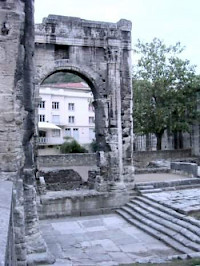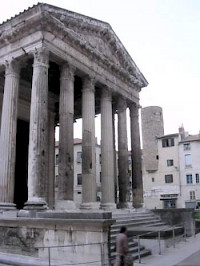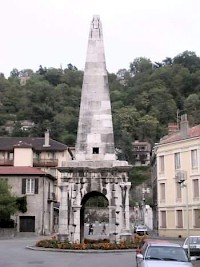Vienna (Vienne)
Q26849Vienna (modern Vienne): Roman city in Gallia Narbonensis.

Vienna was situated on the confluence of the rivers Rhône and Gère. It was founded by the Gallic tribe of the Allobroges, whose oppidum (hillfort) was on the Pipet and Sainte-Blandine hills. The Allobroges were subdued by the Romans in 120 BCE (the conquering consul Quintus Fabius Maximus received the surname Allobrogicus), and were resettled next to the river. The defenses offered by the oppidum, however, became necessary again when the Cimbri and Teutones appeared in the Provence. When Marius had defeated these Germanic tribes, order was restored.
In 61 BCE, the Allobroges, led by a man named Catugnatus, revolted and the inhabitants of Vienna expelled the Roman living in their city; the exiles founded Lugdunum (modern Lyon) and did not return when order was for the second time restored.
Three years later, Julius Caesar decided to pacify the area for good, which eventually led to the conquest of all of Gaul. Vienne remained an important town (its territory stretched towards Geneva) but Lugdunum became the more important city. Animosity between the two towns continued for more than a century. In 69 CE, the populace of Lyon asked the emperor Vitellius to destroy Vienne, which fortunately did not happen.

The emperor Augustus gave Vienna, which had by now become the capital of the increasingly romanized Allobroges, the rank of colonia. This meant that the inhabitants were from now on all Roman citizens. It could also serve as new home for exiles, like the Judaean king Herod Archelaus (6 CE). In 35 CE, the first man from Vienna, Decimus Valerius Asiaticus, reached the consulship.
As a colonia, the city was now called Colonia Julia Augusta Florentia Viennensium. As was customary, the grateful new Romans dedicated a shrine to the emperor, the temple of the divus Augustus et diva Roma, "the divine Augustus and the goddess Roma". (The temple was also called Temple of Augustus and Livia.) In Claudius' speech on civil rights for the Gauls, the city is called "beautifully decorated and powerful", and the poet Martial says the same in one of his epigrams.note
The city's wall tell something about its fate. The Roman town originally had a wall with a length of seven kilometers, but in the third century, the town contracted and a new wall was built, only two kilomters long. These withstood the raids of the Germanic tribe of the Alamans.
In the early fourth century, when the emperors Diocletian and Maximian created smaller provinces, Vienna became capital of the province of Viennensis. Only Trier was in fourth-century Gaul more important, and even in its contracted size, Vienna remained a city of great renown and cultural influence. The emperor Valentinian II resided in Vienna (and was assassinated in this citynote). In the fifth century, its comparative prosperity attracted the Burgundians, who settled in this area after their capital Worms had in 435 been sacked by Aetius and the Huns.

There are several ancient monuments in modern Vienne, like the theater, the Temple of Augustus, and the "Garden of Cybele", where the mysteries of this goddess where performed. Another monument is known as "la pyramide" and was once an element of the hippodrome of Vienna. According to a local story, this monument was the tomb of Pontius Pilate, who was believed to have been sent into exile to Gaul. Of course this is a nothing but a pious legend, but the confusion with Herod Archelaus is understandable.
Vienna used to have a very long wall, more than seven kilometers long. In the third century, a second wall of two kilometers long was erected.